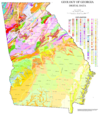IntroductionThe Ordovician (/ɔːrdəˈvɪʃi.ən, -doʊ-, -ˈvɪʃən/ or-də-VISH-ee-ən, -doh-, -VISH-ən) is a geologic period and system, the second of six periods of the Paleozoic Era. The Ordovician spans 41.6 million years from the end of the Cambrian Period 485.4 Ma (million years ago) to the start of the Silurian Period 443.8 Ma. The Ordovician, named after the Welsh tribe of the Ordovices, was defined by Charles Lapworth in 1879 to resolve a dispute between followers of Adam Sedgwick and Roderick Murchison, who were placing the same rock beds in North Wales in the Cambrian and Silurian systems, respectively. Lapworth recognized that the fossil fauna in the disputed strata were different from those of either the Cambrian or the Silurian systems, and placed them in a system of their own. The Ordovician received international approval in 1960 (forty years after Lapworth's death), when it was adopted as an official period of the Paleozoic Era by the International Geological Congress. Life continued to flourish during the Ordovician as it did in the earlier Cambrian Period, although the end of the period was marked by the Ordovician–Silurian extinction events. Invertebrates, namely molluscs and arthropods, dominated the oceans, with members of the latter group probably starting their establishment on land during this time, becoming fully established by the Devonian. The first land plants are known from this period. The Great Ordovician Biodiversification Event considerably increased the diversity of life. Fish, the world's first true vertebrates, continued to evolve, and those with jaws may have first appeared late in the period. About 100 times as many meteorites struck the Earth per year during the Ordovician compared with today. (Full article...) Selected article on the Ordovician world and its legacies Virus particles (known as virions) consist of two or three parts: i) the genetic material made from either DNA or RNA, long molecules that carry genetic information; ii) a proteincoat that protects these genes; and in some cases iii) an envelope of lipids that surrounds the protein coat when they are outside a cell. The shapes of viruses range from simplehelical and icosahedral forms to more complex structures. The average virus is about one one-hundredth the size of the average bacterium. The origins of viruses in the evolutionary history of life are unclear: some may have evolved from plasmids—pieces of DNA that can move between cells—while others may have evolved from bacteria. Viruses are considered by some to be a life form, because they carry genetic material, reproduce, and evolve through natural selection. However they lack key characteristics (such as cell structure) that are generally considered necessary to count as life, so whether or not viruses are truly alive is controversial. (see more...) Selected article on the Ordovician in human science, culture and economics
The geologic map of Georgia (a state within the United States) is a special-purpose map made to show geological features. Rock units or geologic strata are shown by colors or symbols to indicate where they are exposed at the surface. Structural features such as faults and shear zones are also shown. Since the first national geological map, in 1809, there have been numerous maps which included the geology of Georgia. The first Georgia specific geologic map was created in 1825. The most recent state-produced geologic map of Georgia, by the Georgia Department of Natural Resources is 1:500,000 scale, and was created in 1976 by the department's Georgia Geological Survey. It was generated from a base map produced by the United States Geological Survey. The state geologist and Director of the Geological Survey of Georgia was Sam M. Pickering, Jr. Since 1976, several geological maps of Georgia, featuring the state's five distinct geologic regions, have been produced by the federal government. (see more...)
Selected image
Did you know?
Need help?Do you have a question about Abyssal/Portal:Ordovician that you can't find the answer to? Consider asking it at the Wikipedia reference desk. TopicsEpochs - Early Ordovician - Middle Ordovician - Late Ordovician Landmasses - Baltica - Gondwana - Laurentia - Siberia Fossil sites - Beecher's Trilobite Bed - Walcott–Rust quarry Researchers - Charles Emerson Beecher - Charles Lapworth - Charles Doolittle Walcott Quality ContentFeatured Ordovician articles - None SubcategoriesRelated contentAssociated WikimediaThe following Wikimedia Foundation sister projects provide more on this subject:
|




















